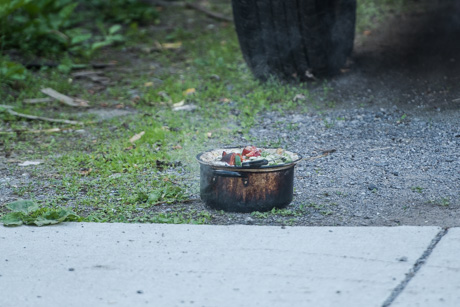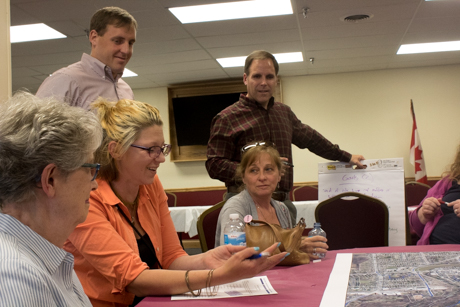Nicholas A. Cianciosi, 68, of 400 E. Main St., Apt. #429, Batavia, is charged with second-degree criminal mischief -- property damage greater than $1,500. The defendant is accused of intentionally knocking over a 2003 Harley-Davidson motorcycle that was parked in the 400 Towers apartment complex parking lot, causing $5,014.78 in damage to the motorcycle. The incident allegedly occurred at 6:15 p.m. on May 23. Cianciosi is due in Batavia City Court on June 21 to answer the charge. The case was handled by Batavia Police Officer Frank Klimjack.
Karissa K. Sardina, 34, of Needham Street, Perry, is charged with endangering the welfare of a child and having an unattended motor vehicle. It is alleged that at 11:55 a.m. on June 1 on Main Street in Batavia that Sardina parked her vheicle in the parking lot of a local bank and left the vehicle running and unattended. She is accused of leaving her 3-year-old daughter in the car to go inside the bank and conduct personal banking business. She was due in City Court June 6 to answer the charges. The case was handled by Batavia Police Officer Frank Klimjack, assisted by Officer Kevin DeFelice.
Marshall R. Steffans, 38, of Condon Avenue, Buffalo, is charged with two counts of endangering the welfare of a child -- acting in a manner injurious to a child under age 17, criminal mischief -- intentionally damaging property, and third-degree criminal assault -- acting with intent to cause physical injury. Steffans was arrested on June 2 on an arrest warrant out of City Court on the charges, which followed his arrest on April 18 on Liberty Street in the city following a domestic incident. The case was handled by Batavia Police Officer Nicole McGinnis, assisted by Officer Arick Perkins.
Michael T. Coffey, 48, of South Main Street, Albion, is charged with third-degree burglary, criminal mischief -- intentionally damaging property, and petit larceny. Coffey was arrested at 6 p.m. on June 5 on East Main Street in Batavia after police responded to a reported burglary in progress. While officers were en route, the suspect was located in the area and detained. Coffey is accused of breaking a window and stealing property from inside the building. He was due in Batavia City Court on June 6. The case was handled by Batavia Police Officer Stephen Cronmiller, assisted by Officer Nicole McGinnis.
Brandon James March, 32, of South Main Street, Batavia, is charged with disabling equipment -- preventing communication with emergency services, and fourth-degree grand larceny -- taking property from another person. March was arrested on Cone Street in Batavia at 10:05 p.m. on June 2 following a domestic incident. March is accused of taking a cell phone belonging to another person while that person was attempting to call 9-1-1. He was jailed without bail and was due in City
Court June 5. The case was handled by Batavia Police Officer Jason Ivison.
Andrew Charles Maier, 30, of Main Road, Corfu, is charged with aggravated DWI with a BAC of .18 percent or more with one prior conviction, DWI with a previous conviction within the last 10 years, and speeding over 55 mph. He was arrested at 8:29 p.m. on June 3 on Colby Road in Pembroke following a traffic stop. He was issued an appearance ticket for Town of Pembroke Court on July 18. The case was handled by Genesee County Sheriff's Deputy Jeremy McClellan, assisted by Deputy Eric Seppala.
Patrick D. Moore, 39, of Strouts Road, Elba, is charged with third-degree criminal mischief -- intentionally damaging another person's property in an amount greater than $250. Moore was arrested June 4 on an arrest warrant out of City Court. Batavia police were dispatched on March 1 to 13 Holland Ave., Batavia, for a disturbance. After an investigation, charges were levied and an arrest warrant was issued for Moore. He was due back in City Court on June 5. The case was handled by Batavia Nicole McGinnis, assisted by Officer Chad Richards.
Bennie Wright, 32, of Jay Street, Rochester, is charged with fourth-degree grand larceny and unlawful possession of marijuana. At 5 p.m. on June 3, Wright allegedly stole money from another person on Central Avenue in Batavia by taking the money out of the person's hand. Wright was allegedly found to possess marijuana during his arrest. The case has handled by Batavia Police Officer Jamie Givens, assisted by Officer Jason Davis.
Nichol L. Schutt, 29, of West Crest Drive, Gates, is charged with second-degree harassment. On June 3, Batavia police arrested Schutt on an arrest warrant -- stemming from an unspecified incident at 1:50 a.m. on June 1 on West Main Street in Batavia -- after Gates police detained her for a traffic stop. She posted $500 bail and was released. She is due in City Court on June 14. The case was handled by Batavia Police Officer Arick Perkins, assisted by Officer Matthew Wojtaszczyk.
Morgan L. Cox Jr., 25, of Xavier Street, Clarence, is charged with DWI, unlicensed operation of a motor vehicle, and refusal to take a breath test. Cox was arrested after an investigation into a fight that occurred on Trumbull Parkway, Batavia, at 11:05 p.m. on June 3. Witnesses allegedly identified Cox as being involved in the fight and claimed he drove away from the scene. He was located in the area and subsequently arrested. He was jailed on $1,000 bail. The case was handled by Batavia Police Officer Jason Ivison, assisted by Officer Felicia DeGroot.
Travis Martin Klotzbach, 26, of Elm Street, Batavia, is charged with: moving from lane unsafely; drinking alcohol in a motor vehicle on a highway; DWI -- common law; and aggravated DWI -- per se -- with a BAC of .18 percent or more. Klotzbach was arrested following a traffic stop at 10:02 p.m. on June 3 on Pearl Street. Police pulled over his 1997 blue Ford Expedition after a complaint of erratic driving. He was allegedly found to be operating the vehicle while intoxicated with a BAC of .23 percent. He was issued traffic tickets and released. He is due in City Court on June 14. The case was handled by Batavia Police Officer Arick Perkins, assisted by Officer Eric Bolles.
Aisha I. Culver, 18, of Willow Street, Batavia, is charged with second-degree harassment -- physical contact, and endangering the welfare of a child -- acting in a manner injurious to a child under age 17. She was arresred on May 26 on Willow Street. The charges are linked to a disturbance that police responded to at 8:05 p.m. on May 20 on Maple Street. She was released with an appearance ticket and was due in City Court on May 30. The case was handled by Batavia Police Officer Nicole McGinnis, assisted by Officer Arick Perkins.
David P. Grossman Sr., 34, of West Main Street Road, Batavia, is charged with obstructing governmental administration and unlawful possession of marijuana. The charges stem from an incident at 5:44 p.m. on March 1 on State Street, Batavia. Officers responded to a distrubance and it is alleged that Grossman Sr. was resistant with officers and tried to prevent the officers from taking him into custody. After his arrest, he was allegedly found to possess marijuana. He was due in City Court June 6. The case was handled by Batavia Police Officer Chad Richards, assisted by Officer Frank Klimjack.
Dora L. Poodry, 23, of East Main Street, Batavia, is charged with petit larceny. She was arrested on May 28 on East Main Street in Batavia after allegedly stealing multiple items from a convenience store. She was issused an appearance ticket and was due in City Court on June 6. The case was handled by Batavia Police Officer Stephen Cronmiller, assisted by Officer Lindsay Christopher.
Thomas A. Carson, 41, of Wood Street, Batavia, was arrested on June 5 on a Batavia City Court bench warrant issued May 5. He was jailed on $2,500 bail and was due back in court the same day as his arrest, June 5. The case was handled by Batavia Police Officer Jason Ivison, assisted by Officer Matthew Wojtaszczyk.
Patrick J. Dickinson, 48, of East Henrietta Road, Henrietta, is charged with second-degree harassment and unlawful possession of marijuana. He was arrested following the investigation into a road rage incident which occurred at 10:05 a.m. on June 3 on Main Street in Batavia. Dickinson is accused of chasing down the occupants of another vehicle and shoving one of them. At the time of his arrest, marijuana was allegedly located inside his vehicle. He was released on an appearance ticket was due in City Court on June 6. The case was handled by Batavia Police Officer Jason Ivison, assisted by Sgt. Dan Coffey.
Christopher M. Grant, 28, of Schaefer Drive, West Seneca, was arrested June 3 on a bench warrant out of City Court. The warrant was issued after Grant failed to appear on a misdemeanor traffic ticket. He posted $250 bail and was released. He is due back in City Court on June 20. The case was handled by Batavia Police Officer Christopher Lindsay.
















































